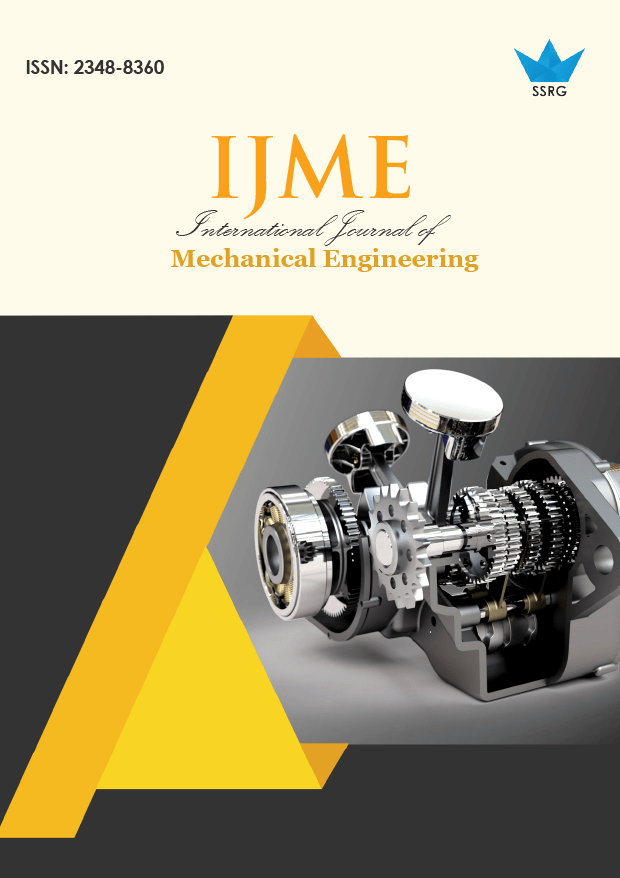Predicting the Transfer Function and Analyzing a Control System for Recycling Spent Engine Oil using Graphical User Interfaces

| International Journal of Mechanical Engineering |
| © 2025 by SSRG - IJME Journal |
| Volume 12 Issue 3 |
| Year of Publication : 2025 |
| Authors : Salah Eldeen Hegazi |
How to Cite?
Salah Eldeen Hegazi, "Predicting the Transfer Function and Analyzing a Control System for Recycling Spent Engine Oil using Graphical User Interfaces," SSRG International Journal of Mechanical Engineering, vol. 12, no. 3, pp. 56-60, 2025. Crossref, https://doi.org/10.14445/23488360/IJME-V12I3P104
Abstract:
One of the most important environmental and financial issues is how to dispose of and recycle old engine oil. The acidic approach, which uses acids to remove pollutants and impurities, is one of the popular methods to recycle used engine oil. The paper addresses the theoretical concepts and the practical applications of identifying the transfer function by the graphical user interface using GUI as a MATLAB toolbox. The transfer function is a pivotal key tool for control system analysis and dissection of the backbone of the control system. The paper’s novelty evaluates the control system characteristics such as rise time, peak time, and process time constant for recycling used engine oil. The methodology followed by this paper is the prediction of the control system transfer function in the Laplace domain for controlling the temperature of the process. The viscosity and density of the synthesized oil were monitored and measured. In addition, the characteristics of the control system, like settling time, rise time, and overshoot, were investigated and estimated. The results obtained are the process gain constant, kc = 0.059, and the time constant, ɽp = 13.42, based on the first-order transfer function predicted from the GUI. Moreover, the paper fills the gap in implementing control systems in this era of recycling used engine oil.
Keywords:
Recycle, Engine oil, Acidic, Transfer function, Graphical User Interphase, Identification, Control system.
References:
[1] S.O. Ogbeide, “An Investigation to the Recycling of Spent Engine Oil,” Journal of Engineering Science and Technology Review, vol. 3, no. 1, pp. 32-35, 2010.
[CrossRef] [Google Scholar] [Publisher Link]
[2] R. Abu-Elella et al., “Used Motor Oil Treatment: Turning Waste Oil Into Valuable Products,” International Journal of Chemical and Biochemical Sciences, vol. 7, pp. 57-67, 2015.
[Google Scholar] [Publisher Link]
[3] Afreen Nissar, M. Hanief, and Fasil Qayoom Mir, “Experimental Assessment of Recycling Methods of Used Engine Oil for Sustainable Environment,” Research on Engineering Structures and Materials, vol. 8, no. 3, pp. 553-567, 2022.
[CrossRef] [Google Scholar] [Publisher Link]
[4] Sayantan Sarkar et al., “Comprehensive Investigation of Various Re-Refining Technologies of Used Lubricating Oil: A Review,” Journal of Material Cycles and Waste Management, vol. 25, no. 4, pp. 1935-1965, 2023.
[CrossRef] [Google Scholar] [Publisher Link]
[5] F.O. Ugwele et al., “Application of Response Surface Methodology in Optimizing the Process Conditions for the Regeneration of Used Mobil Oil Using Different Kinds of Acids,” Heliyon, vol. 6, no. 10, pp. 1-14, 2020.
[CrossRef] [Google Scholar] [Publisher Link]
[6] Min Zhu et al., “Evaluating the Renewal Degree for Expressway Regeneration Projects Based on a Model Integrating the Fuzzy Delphi Method, the Fuzzy AHP Method, and the TOPSIS Method,” Sustainability, vol. 15, no. 4, pp. 1-27, 2023.
[CrossRef] [Google Scholar] [Publisher Link]
[7] Surajudeen Adewusi, “Modeling and Parameter Identification of a DC Motor Using Constraint Optimization Technique,” IOSR Journal of Mechanical and Civil Engineering, vol. 13, no. 6, pp. 46-56, 2016.
[CrossRef] [Google Scholar] [Publisher Link]
[8] Yu-Lung Hsu, and Chun-Chu Liu, “Evaluation and Selection of Regeneration of Waste Lubricating Oil Technology,” Environmental Monitoring and Assessment, vol. 176, no. 1, pp. 197-212, 2011.
[CrossRef] [Google Scholar] [Publisher Link]
[9] Sayantan Sarkar et al., “A Comprehensive Study of Method Optimisation of Re‐Refining Spent Lubricating Oil,” Lubrication Science, vol. 36, no. 7, pp. 531-539, 2024.
[CrossRef] [Google Scholar] [Publisher Link]
[10] Taufika Islam Anee, Parimal Kanti Biswas, and Mirza Hasanuzzaman, “Changes in Morpho-Physiological and Yield Attributes of Sesamum Indicum Under Waterlogging at Different Growth Stages,” Journal of Bangladesh Academy of Sciences, vol. 46, no. 2, pp. 165-173, 2022.
[CrossRef] [Google Scholar] [Publisher Link]
[11] Abdullah Jabar Hussain, Zainab S. Al-Khafaji, and Iman Q. Al Saffar, “New Recycling Method of Lubricant Oil and the Effect on the Viscosity and Viscous Shear as an Environmentally Friendly,” Journal Open Engineering, vol. 14, no. 1, pp. 1-10, 2024.
[CrossRef] [Google Scholar] [Publisher Link]
[12] S.A. Ratiu et al., “Overview on Globally Applied Used Engine Oil Recycling Technologies,” IOP Conference Series: Materials Science and Engineering: The XXXI-st SIAR International Congress of Automotive and Transport Engineering Automotive and Integrated Transport Systems, Chisinau, vol. 1220, no. 1, pp. 1-10, 2022.
[CrossRef] [Google Scholar] [Publisher Link]
[13] Mohammad Shamsuzzoha, and Sigurd Skogestad, “The Setpoint Overshoot Method: A Simple and Fast Closed-Loop Approach for PID Tuning,” Journal of Process Control, vol. 20, no. 10, pp. 1220-1234, 2010.
[CrossRef] [Google Scholar] [Publisher Link]

 10.14445/23488360/IJME-V12I3P104
10.14445/23488360/IJME-V12I3P104